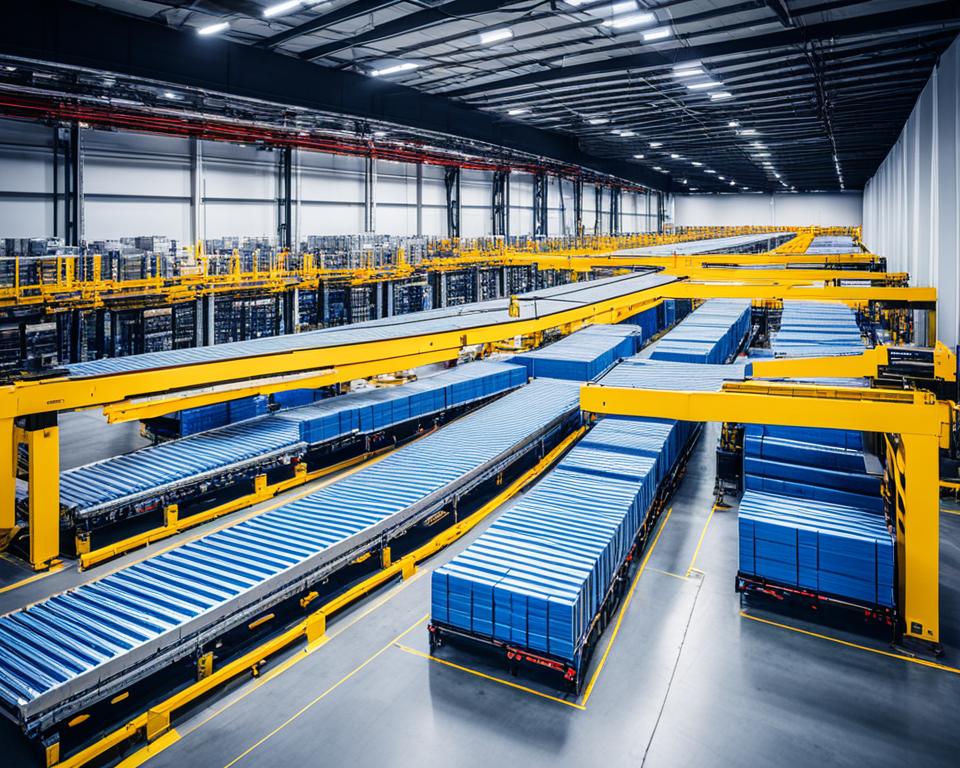Ever thought about how businesses boost their warehouse work without changing their whole logistics setup? SAP Extended Warehouse Management (EWM) helps with that. It makes operations smoother and keeps track of inventory better. This tool is great for making warehouses run more efficiently and smoothly.
Looking into SAP EWM, I saw how it could give me an edge in logistics. It cuts down on costs and increases productivity by managing inventory well. With SAP EWM, I can make my operations more efficient and accurate, which is key for logistics success.
Want to learn more about how SAP EWM can change warehouse management? Check out this detailed guide on SAP and its programming language ABAP.
Key Takeaways
- SAP EWM provides tools for effective warehouse management.
- Streamlining operations can lead to enhanced inventory accuracy.
- Adopting SAP EWM can result in reduced operational costs.
- Warehouse automation increases efficiency and productivity.
- Integration with logistics optimization tools is seamless with SAP EWM.
Understanding SAP EWM
SAP EWM is all about making warehouse management better and making logistics smoother. It automates key tasks like tracking inventory, managing storage spots, and filling orders. This helps me keep my inventory very accurate.
The Fundamentals of SAP EWM
SAP EWM is known for its flexible design. This lets me tailor the system to fit my warehouse’s specific needs. It handles many warehouse tasks, like keeping an eye on stock and making sure storage is used well. Using this system makes my warehouse run more smoothly and efficiently.
Using SAP EWM brings many benefits, such as:
- Improved inventory accuracy with real-time data.
- Automation of routine tasks, cutting down on mistakes.
- Better visibility of logistics processes for faster decisions.
- More flexibility to meet market changes.
As I explore SAP EWM more, I see how its smart design and setup can help many industries. It changes how I manage my warehouse and logistics.
Benefits of SAP EWM for Warehouse Management
Using SAP EWM makes warehouse management better in many ways. It boosts efficiency and productivity. It also makes operations run smoother.
Increased Efficiency and Productivity
SAP EWM makes work flow smoothly, cutting down on mistakes and speeding up orders. It helps manage labor and resources better. Automated tasks like tracking inventory and picking orders work faster and better.
This leads to big savings, thanks to less labor cost and more accuracy. With SAP EWM, my warehouse works better and saves money. It uses real-time data and analytics to help make smart choices and work better with suppliers.

The advantages of SAP EWM build a strong system that boosts operations and encourages new ideas. For more on better procurement practices, check out this resource.
Key Features of SAP EWM
SAP EWM has many key features that meet the needs of warehouse management. It makes handling inventory more efficient and accurate.
Comprehensive Functionalities
The system is great at managing inventory details. It keeps track of every item in the warehouse. SAP EWM’s main features are:
- Advanced Material Tracking: This lets me track products in real-time. I always know where all my inventory is.
- Efficient Management of Warehouse Tasks: I can easily manage and check on warehouse tasks. This helps keep the workflow smooth.
- Automation Tools: SAP EWM uses automation to make repetitive tasks faster. This cuts down on time and makes responses quicker.
These features help me work better and more accurately. SAP EWM is a key tool for managing warehouses well.
| Feature | Description | Benefit |
|---|---|---|
| Inventory Management | Tracks inventory levels, locations, and statuses | Improves accuracy and reduces stock discrepancies |
| Material Tracking | Real-time visibility of all materials | Enables timely decision-making and response |
| Warehouse Task Management | Assigns tasks to warehouse personnel | Optimizes resource allocation and workflow efficiency |
| Automation Tools | Automates repetitive warehouse tasks | Reduces manual errors and increases productivity |
Warehouse Automation with SAP EWM
Warehouse automation is key to making SAP EWM work better. It makes many tasks easier and faster. This means I can do more with less manual work, which cuts down on mistakes.

Enhancing Operational Efficiency
Using SAP EWM, tasks like picking, packing, and shipping happen smoothly. This makes my warehouse a place where things run well. I can ship things out faster and more accurately, which makes customers happy.
By investing in automation, I can keep a close eye on how things are going. I can make smart choices based on real-time data. This helps me keep my warehouse running at top level, setting the standard for others.
Enhancing Inventory Management through SAP EWM
For any business, managing inventory well is key to making warehouse processes better. Using SAP EWM gives me the tools I need for real-time stock level checks. This helps me make smarter choices about buying and logistics.
Real-time Inventory Visibility
With SAP EWM, I can see where and how stock is moving right now. This real-time visibility cuts down on stockouts and too much inventory. It makes my stock control better. Here are some ways this system helps:
- Provides instant updates on stock levels, helping me make quick, informed decisions.
- Makes streamlined operations by cutting down on delays in getting inventory info.
- Supports proactive planning by letting me quickly adjust my buying strategies.
This leads to a more efficient supply chain that keeps customers happy. Below is a table showing how SAP EWM is better than old inventory systems.
| Feature | SAP EWM | Traditional Systems |
|---|---|---|
| Real-time Tracking | Yes | No |
| Data Accuracy | High | Medium |
| Stock Control Efficiency | Optimized | Limited |
| Response Time | Immediate | Delayed |
Supply Chain Optimization using SAP EWM
Using SAP EWM changes how I manage my supply chain. It makes it easier to handle inventory across different sales channels. This leads to better efficiency and quicker responses to customer needs.
Coordinating Multichannel Logistics
SAP EWM helps me manage my supply chain better. It ensures inventory is updated in real-time across all channels. This means shorter lead times and happier customers, which improves supply chain performance.
The following table shows how SAP EWM makes these improvements:
| Aspect | Before SAP EWM | After SAP EWM |
|---|---|---|
| Inventory Visibility | Poor visibility across channels | Real-time visibility and updates |
| Lead Times | Long and unpredictable | Shortened and consistent |
| Customer Service | Inconsistent order fulfillment | Improved accuracy and speed |
| Process Coordination | Manual and error-prone | Automated and efficient |
Integrating Logistics Software with SAP EWM
When I connect logistics software with SAP EWM, my operations get a big boost. This combo makes my supply chain more efficient and clear. It’s all about making sure different systems work together smoothly.
This means I can easily work with outside logistics companies and other business tools. The data flows better, making my operations run smoother.
Seamless Connectivity
Being able to link logistics software with SAP EWM helps me manage my logistics better. I can make my workflows more efficient, cutting down on manual tasks. This lets me make smarter decisions based on data.
The SAP Ariba Modules are key in making these improvements. They bring more visibility and efficiency to my procurement. In the end, I save money and see better performance from my suppliers.
Material Handling Solutions in SAP EWM
Handling materials well is key to boosting productivity and making the most of warehouse space. In my work with SAP EWM, I’ve found many features that help use space wisely and make handling more efficient. By using strategies like slotting and dynamic storage, I make sure every bit of space counts. This leads to better control over our inventory.
Optimizing Warehouse Space
Using SAP EWM’s material handling solutions really helps make the most of warehouse space. Here are some key methods I use:
- Dynamic Slotting: Changes storage spots based on how often items are used, so the most wanted items are easy to find.
- Storage Assignment Execution: Uses up-to-date info to pick the best spot for each item, considering its size and weight.
- Cycle Counting: Counts inventory regularly to keep it accurate and make sure storage is always optimal.
- Cross-Docking: Moves goods straight from receiving to shipping, cutting down on the need for storage.
These methods help me handle materials better, which greatly improves how well the warehouse runs. Below is a table that shows how SAP EWM’s advanced features beat traditional methods in handling and optimizing space.
| Aspect | Traditional Methods | SAP EWM Solutions |
|---|---|---|
| Space Utilization | Static storage spots; hard to change | Dynamic slotting; adjusts to demand |
| Handling Efficiency | Picking takes a lot of time; often causes delays | Optimized picking paths; cuts down on travel time |
| Inventory Accuracy | Manual counting; often leads to mistakes | Automated updates; counts in real-time |
| Adaptability | Set processes; hard to change quickly | Flexible setups; can adjust fast |

RFID Tracking in SAP EWM
Using RFID tracking in SAP EWM has changed how I manage inventory. This tech lets me track inventory movements in real-time. It uses RFID tags to cut down on stock count errors.
Enhancing Tracking Accuracy
RFID tracking offers inventory visibility that old methods can’t match. It shows where each item is and its status. This info helps me make smart choices to improve warehouse operations.
Adding RFID tracking to SAP EWM boosts my inventory management. It also makes my warehouse run better. The main benefits are:
- Improved stock counts with real-time updates.
- Less errors in picking and shipping.
- Quicker fixes for inventory issues.
- Better forecasting of inventory needs.
RFID tracking and SAP EWM work together for smarter inventory management. This makes my warehouse operations more efficient and ready for market changes.
| Feature | Traditional Methods | RFID Tracking in SAP EWM |
|---|---|---|
| Data Accuracy | Medium | High |
| Real-time Updates | No | Yes |
| Inventory Discrepancies | Frequent | Rare |
| Operational Efficiency | Moderate | Enhanced |
Mobile Data Collection in Warehouse Operations
Mobile data collection is changing how warehouses work, thanks to SAP EWM. Now, I can gather data right from the warehouse floor using mobile devices. This makes getting data easier and helps update inventory quickly, making things more efficient.
Streamlining Data Acquisition
Using mobile data collection makes warehouse tasks easier. The benefits are clear:
- Real-Time Updates: I get the latest inventory info right away.
- Enhanced Accuracy: Fewer mistakes happen with automated entries.
- Increased Productivity: I have more time to focus on important tasks.
With SAP EWM and mobile data collection, I boost my work flow and make better decisions. I get real-time data from the warehouse, which helps track goods better and keeps data accurate.

| Benefits | Impact on Warehouse Operations |
|---|---|
| Real-Time Data | Improves inventory visibility |
| Time Efficiency | Less time spent on manual processes |
| Accuracy | Reduces discrepancies in inventory counts |
| Operational Clarity | Enables quicker decision-making |
Adding mobile data collection to my warehouse, with SAP EWM, brings big wins in efficiency and performance. It’s key for keeping up with today’s fast-paced inventory needs, helping me stay ahead in the market.
Improving Labor Management with SAP EWM
SAP EWM helps organizations improve how they manage labor. It uses advanced tools for tracking performance. This lets me use my team’s skills better, making sure they work efficiently.
This way, I can cut costs and increase what we produce, especially when demand is high.
Workforce Optimization
Optimizing the workforce means looking at how well labor performs and produces. SAP EWM lets me use several strategies for better labor management:
- Real-time tracking helps me see how individuals and teams are doing. This lets me help them quickly when needed.
- Features for assigning tasks make sure the right people do the right jobs, making work flow better.
- Special reports give me insights into labor trends and patterns. This helps me make smart choices to improve efficiency.
- Training and development plans are based on real data. They focus on areas where we need to get better.
These tools put together a strong system for managing labor. They help me meet my goals by using my team’s strengths well. This leads to a more productive and motivated team while keeping costs down.
Implementing Slotting Optimization Strategies
Using slotting optimization in SAP EWM is key to better use of space and faster picking in my warehouse. I look at how often products are used and how fast they move. This helps me pick the best spots for storage, making picking faster and cutting down on walking for my team.
Efficient Space Utilization
My goal is to use every inch of space wisely. Here’s how I do it:
- Analyzing item velocity to find the best spots.
- Changing inventory layout based on the seasons.
- Using SAP EWM data to make smart slotting choices.
Putting products in the right places makes picking faster and gets items quicker during busy times.

This approach leads to smoother operations, quicker order handling, and lower costs. Slotting optimization changes how my warehouse works, setting the stage for ongoing success.
| Strategy | Description | Benefits |
|---|---|---|
| Demand Analysis | Look at how often products move to decide where to put them. | Speeds up picking and makes it more accurate. |
| Dynamic Slotting | Change storage spots with the latest data. | Uses space and resources better. |
| Seasonal Adjustments | Adjust storage for seasonal changes and busy times. | Keeps up with market changes better. |
Challenges in Adopting SAP EWM
Adopting SAP Extended Warehouse Management (EWM) brings many benefits but also challenges. Organizations face obstacles that make it hard to implement it well. It’s key to tackle these challenges to make the transition smooth and improve efficiency.
Overcoming Adoption Barriers
Staff resistance to change is a big hurdle. People used to the old ways might not want to switch. Training programs that show the benefits of SAP EWM can help. This makes it easier for staff to accept new methods and get excited about them.
Integrating SAP EWM with old systems can cause problems. It’s important that all systems work well together. Getting IT experts to check things out can help find and fix issues early.
Good communication is key to overcoming these hurdles. Keeping everyone updated on SAP EWM’s progress and benefits keeps morale up and encourages teamwork. A feedback system lets staff share their thoughts, making sure their ideas are heard during the change.
Dealing with the challenges of SAP EWM can be tough. But, with good training, solving integration problems, and keeping communication open, success is more likely. Companies wanting to improve their procurement might look into integration options to make things smoother.
| Challenges | Solutions |
|---|---|
| Resistance to Change | Comprehensive Training Programs |
| Integration Issues | Engage IT Professionals for Assessments |
| Lack of Communication | Regular Updates and Feedback Mechanisms |
Real-World Success Stories: SAP EWM in Action
Looking at real success stories shows how companies use SAP EWM to boost their operations. These case studies share stories of SAP EWM success in different fields. They show how it leads to better performance, like shorter lead times and more accurate inventory.
Case Studies and Results
Seeing how SAP EWM works in real life is very helpful. Here are some key examples of how companies have seen big improvements:
| Company | Industry | Challenges | Solutions Implemented | Results Achieved |
|---|---|---|---|---|
| Company A | Retail | High lead times | Implemented advanced slotting strategies | 30% reduction in lead times |
| Company B | Manufacturing | Poor inventory visibility | Utilized real-time inventory tracking | Improved inventory accuracy by 25% |
| Company C | Pharmaceutical | Regulatory compliance issues | Adopted detailed audit trails in inventory | Achieved 100% compliance in audits |
These stories show how SAP EWM can really help improve performance. By looking at case studies, we see how effective SAP EWM is. It gives useful tips for companies thinking about using it too.
Future Trends in Warehouse Management
The world of warehouse management is changing fast, thanks to new technologies. It’s crucial for businesses to keep up to stay ahead. I see big changes coming that will change how things work a lot.
Innovations on the Horizon
AI and automation are leading the way in warehouse management. Smart warehouses with AI and robotics are the future. These changes make things more efficient and cut costs. They also help with making better decisions.
- Smart Warehouses: Using AI to manage inventory better and use space well.
- Predictive Analytics: Using data to predict demand and make operations smoother.
- Robotics: Automating tasks to boost productivity and accuracy.
Using SAP technologies with these trends will make things even better. Companies that adopt these changes will save money and make customers happier. They’ll offer faster and more precise services.
| Innovation | Impact on Warehouse Management |
|---|---|
| Artificial Intelligence | Makes decisions and forecasts more accurate. |
| Automation | Lowers labor costs and boosts efficiency. |
| Robotics | Improves picking and packing, reducing mistakes. |
| Predictive Analytics | Helps with planning and managing inventory. |
Knowing about these changes helps me get ready for the future of warehouse management. Using these technologies wisely could be key to success in logistics for years to come.
Conclusion
Using SAP EWM can really boost my warehouse’s efficiency. It helps me tackle challenges and keep up with new trends in logistics. This system makes processes smoother and improves how I manage inventory.
With the help of SAP EWM, my company can handle the complex supply chain better. Adopting advanced warehouse solutions gives us a competitive edge. It leads to better operations and more efficiency.
Having a strong logistics strategy with SAP EWM insights gives me the tools for growth. I’m dedicated to using these insights for better warehouse management.
FAQ
What is SAP EWM and how does it benefit warehouse management?
SAP Extended Warehouse Management (EWM) is a top-notch logistics software. It makes warehouse management better by automating and optimizing processes. It helps improve inventory accuracy, boosts efficiency, and cuts down on costs. This lets me run my warehouse more smoothly.
How can SAP EWM help with inventory management?
SAP EWM gives me real-time updates on inventory levels and movements. This helps me control stock better. With tools for mobile data collection and RFID tracking, I can make smart choices. This reduces stockouts and cuts down on excess inventory.
What are the key features of SAP EWM?
SAP EWM has advanced material handling, detailed inventory management, and labor management tools. It also has automation capabilities. These features help optimize warehouse tasks and boost overall performance.
How does warehouse automation work with SAP EWM?
With SAP EWM, automating processes like picking, packing, and shipping is key. This cuts down on manual labor, reduces errors, and boosts efficiency. It lets me get orders out faster.
What role does slotting optimization play in SAP EWM?
Slotting optimization in SAP EWM means assigning storage spots based on product demand and how often they move. This strategy helps me use space better and pick items faster. It leads to quicker order processing.
Can SAP EWM integrate with other logistics software?
Yes, SAP EWM works well with other logistics software and third-party providers. This connection improves my operations by sharing data and optimizing workflows across my supply chain.
What challenges might I face when implementing SAP EWM?
Challenges include resistance to change, issues with integrating with current systems, and the need for staff training. Overcoming these requires careful planning and clear communication for a smooth setup.
How does SAP EWM improve labor management?
SAP EWM helps with labor management by tracking performance and allocating resources. This lets me use my team better. It leads to more productivity, lower labor costs, and better management during busy times.
What innovations in warehouse management can I expect in the future?
Future trends will likely bring more AI and robotics to warehouse management. As these technologies grow, I’ll see smarter warehousing solutions. These will use predictive analytics to make operations more efficient and reduce costs.


